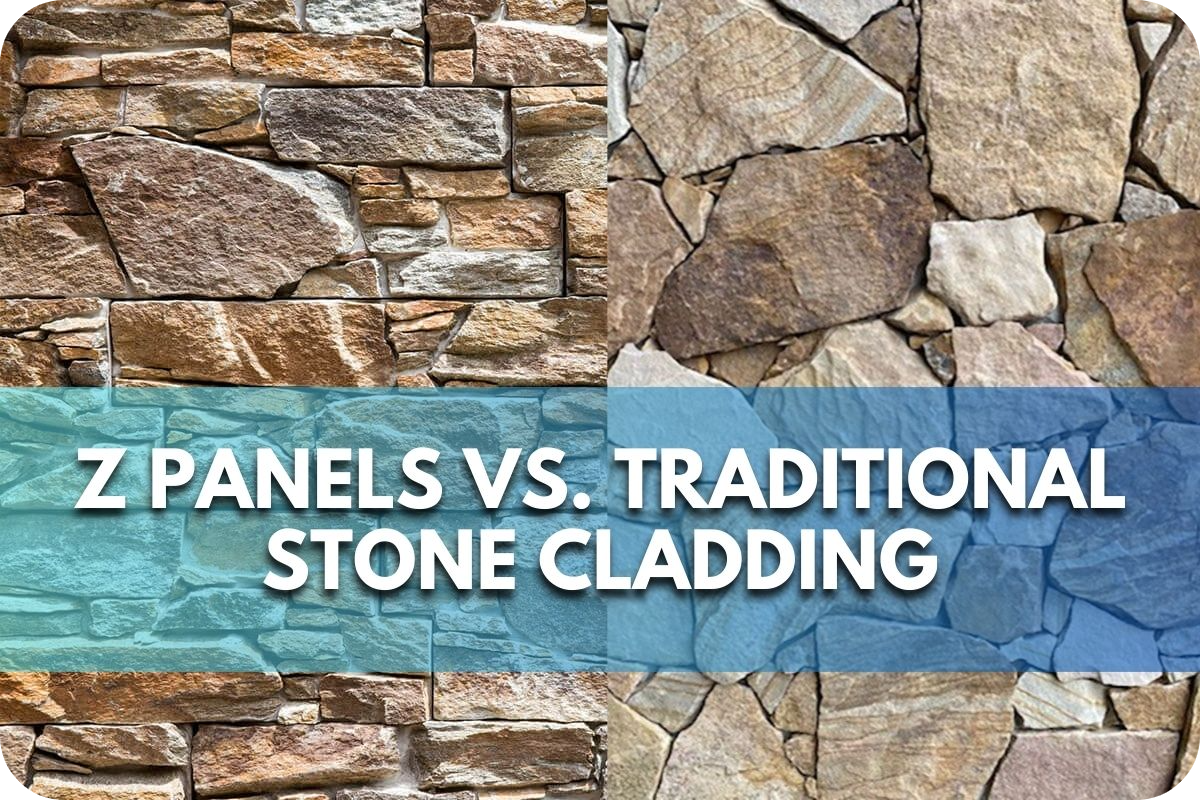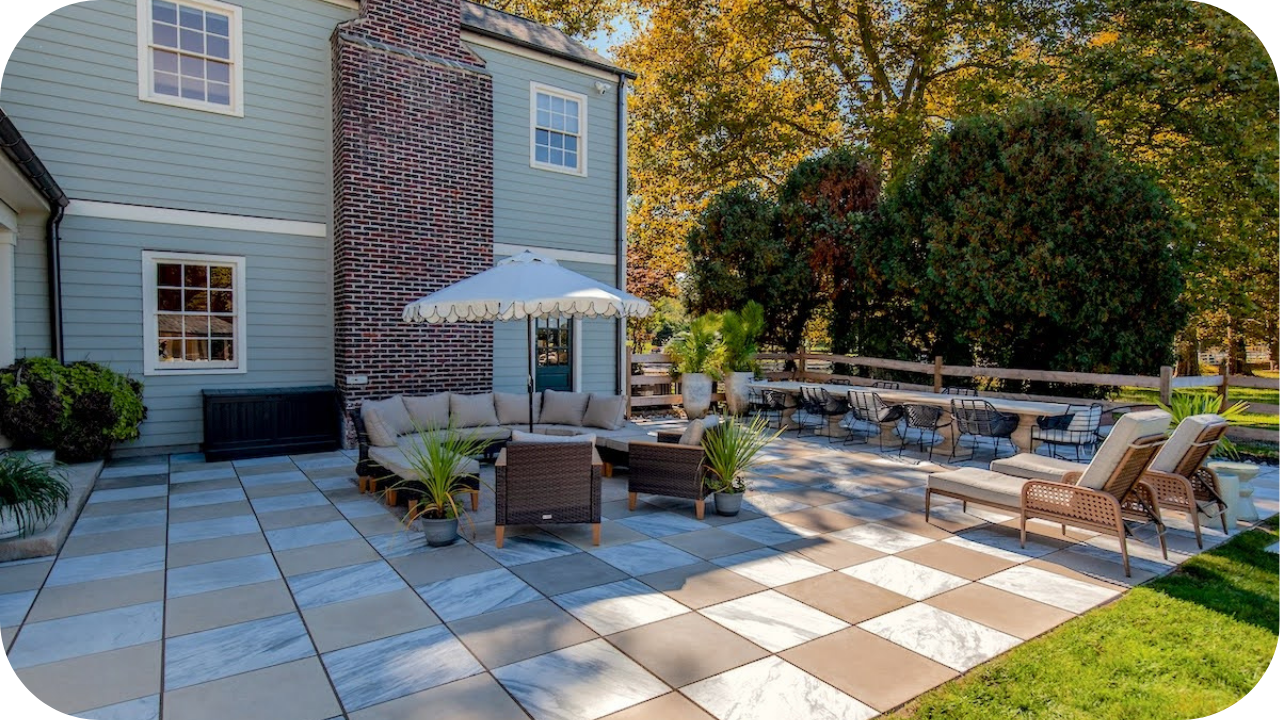
Choosing the right exterior cladding for your project can be daunting. You want a beautiful look, but installation challenges and high costs can be major obstacles.
Traditional stone cladding offers timeless elegance but is heavy, labour-intensive, and can drive your budget sky-high.
Z Panels provide a compelling alternative. They offer the gorgeous appearance of natural stone in a lightweight, easy-to-install, and more cost-effective format.
What are Z Panels?
Z Panels are lightweight and innovative prefabricated building panels for exterior wall cladding. They typically consist of a metal core, often aluminium, sandwiched between two thin layers of a weather-resistant material. These layers can be crafted from various materials, including:
| Material | Aesthetic |
| Stone Veneer: | Realistic and beautiful stone aesthetic at a fraction of the weight and cost of solid stone. |
| Metal: | A sleek and contemporary look with a high degree of durability. |
| Composite Materials: | Combine the aesthetics of natural materials with the strength and lightweight properties of composites. |
Unique Characteristics
- Lightweight: Significantly lighter than traditional stone cladding, reducing structural load on buildings and simplifying installation.
- Interlocking Design: Z Panels feature an interlocking design, allowing fast and efficient installation with minimal skilled labour required.
- Durability: The metal core and weather-resistant outer layers offer excellent resistance to harsh weather conditions, including UV rays, wind, rain, and hail.
- Low Maintenance: Z Panels require minimal maintenance compared to natural stone, which can be prone to staining and require periodic resealing.
- Design Flexibility: Z Panels come in various colours, textures, and finishes, allowing for a high degree of design flexibility to achieve the desired aesthetic.
Benefits Compared to Stone Cladding
- Reduced Costs: Z Panels offer a more cost-effective solution than traditional stone cladding due to lower material and installation costs.
- Faster Installation: The lightweight and interlocking design enables faster installation times, reducing project timelines.
- Easier Handling: The lighter weight simplifies handling and transportation, making Z Panels ideal for high-rise buildings or projects with limited access.
- Improved Energy Efficiency: Some Z Panel materials, due to their lighter weight and potential insulating properties, can contribute to improved building energy efficiency.
What is Traditional Stone Cladding?
Traditional stone cladding involves using quarried natural stone sliced into thin slabs or tiles to provide a decorative and protective layer over a building’s exterior walls.
This age-old practice offers unparalleled natural beauty, texture, and durability.
Characteristics
- Authenticity: Nothing replicates the genuine beauty and variations found in natural stone.
- Longevity: Properly installed, stone cladding can last centuries, outlasting most other building materials.
- Variety: Natural stone comes in many types, colours, and textures, offering unmatched design versatility.
Types of Stone
- Granite: Extremely durable, popular for its strength and striking visuals.
- Limestone: Softer than granite, offering a classic look and easier fabrication.
- Marble: Prized for its luxurious elegance and veining patterns.
- Sandstone: Warm, earthy tones and a textured surface.
Installation Process
- Surface Preparation: Existing walls must be structurally sound and prepared to receive the stone.
- Mortar and Anchors: Specialised mortar and sometimes mechanical anchors hold the heavy stone in place.
- Grouting: Grout fills the joints between stones, enhancing the look and weatherproofing.
Installation Process: Simplicity vs. Skill
Z Panels: Easy and Efficient
- Substrate Preparation: The surface must be clean, level, and plumb. A weather-resistant barrier may be required.
- Installing Starter Track: A level starter track is secured to the base of the wall to support the first row of panels.
- Interlocking Panels: Z Panels slide and snap together thanks to their interlocking design, allowing for rapid installation.
- Cutting to Fit: Z Panels can be easily cut with standard tools like a circular saw.
The lightweight design and straightforward process make Z Panels suitable for DIY installation with proper preparation and guidance.
Traditional Stone Cladding: Complex and Labour-Intensive
- Substrate Preparation: Often requires a wire mesh and scratch coat of mortar for a strong base.
- Mortar Application: Specialised mortar is carefully applied to the substrate and the backs of stones.
- Setting Stones: Stones are carefully positioned with spacers, requiring skilled labourers to maintain level and plumb lines.
- Cutting Stones: Precise cutting often requires a wet saw and experience with masonry work.
- Grouting: Grout is applied to fill joints between stones, adding a finishing touch and additional weather resistance.
Costs Comparison
While both Z Panels and natural stone offer aesthetic appeal, their cost profiles differ significantly.
Z Panels: The Cost-Effective Choice
- Material: Z Panels are usually more affordable per square metre than natural stone.
- Labour: The ease of installation significantly reduces labour costs, another significant advantage of Z Panels.
- Transportation: Their lighter weight also contributes to lower transportation costs.
Traditional Stone Cladding: A Luxury Expense
- Material: Quarried natural stone is inherently more expensive, especially select varieties of granite or marble.
- Labour: Skilled masons charge higher fees, and the installation process is more time-consuming, driving up labour costs.
- Structural Support: The added weight of stone may necessitate reinforcing the existing building structure, which could add another potential cost.
Budgeting Considerations
- Project Size: The larger the area, the more pronounced the cost difference between the two options becomes.
- Material Choice: Material choices can influence costs (e.g., basic vs. premium stone) within both categories.
- DIY vs. Professional: Opting for DIY installation of Z Panels can further reduce costs but consider your skill level.
Aesthetics and Design Options: Modern vs. Timeless
Z Panels: Modern Versatility
- Variety: Z Panels offer a surprising range of colours, textures, and finishes, convincingly mimicking natural stone or offering sleek metallic appearances.
- Contemporary Style: They are well-suited for modern or contemporary architectural designs, emphasising clean lines and a less rustic aesthetic.
- Flexibility: The ease of installation allows for creative applications, including accent walls or geometric patterns.
Traditional Stone Cladding: Unmatched Natural Beauty
- Authenticity: Nothing can fully replicate the unique variations and organic beauty found within each piece of natural stone.
- Timeless: Stone cladding exudes permanence and classic elegance, complementing various architectural styles.
- Texture: Stone offers a diverse tactile experience, from smooth honed finishes to rough, rugged surfaces.
Design Considerations
- Architectural Style: Match the cladding to your home’s overall design – traditional styles often benefit from stone, while modern homes may lean towards Z Panels.
- Personal Preference: Do you value the genuine look of stone, or are you drawn to the customisation potential of Z Panels?
- Maintenance: Natural stone may require occasional resealing, while Z panels are virtually maintenance-free.
Durability and Maintenance: Long-Term Considerations
Z Panels: Built to Last
- Weather Resistance: High-quality Z Panels are designed to withstand harsh elements like UV rays, wind, rain, and extreme temperatures.
- Minimal Maintenance: They typically require occasional cleaning with mild soap and water to maintain their appearance.
- Resistance to Impacts: While not as impact-resistant as natural stone, many Z Panels are engineered to handle moderate impacts without significant damage.
Traditional Stone Cladding: Enduring, with Care
- Strength: Natural stone is inherently durable and can last centuries with proper care.
- Susceptibility to Staining: Porous stones might require sealing to protect against stains from liquids or chemicals.
- Maintenance: Periodic resealing and cleaning may be necessary, especially in harsh climates.
Tips for Longevity
- Z Panels: Choose high-quality Ones with a proven track record and warranties.
- Traditional Stone: Select suitable stone types for your climate and seal them professionally for optimal protection.
- Both: Address any water intrusion issues on your building’s exterior to prevent long-term deterioration of any cladding material.
Environmental Impact: Weighing the Footprint
Z Panels: A Lighter Footprint
- Manufacturing: Producing Z Panels generally requires less energy and produces fewer emissions than quarrying and processing natural stone.
- Transportation: Their lightweight nature significantly reduces the environmental impact of transportation from manufacturing to the job site.
- Recyclability: Metal and some composite Z Panels can be recycled at the end of their lifespan.
Traditional Stone Cladding: Consider the Source
- Quarrying: Stone extraction can have a significant environmental impact, including habitat disruption and energy-intensive processes.
- Transportation: Heavy stone requires substantial fuel for transportation, contributing to carbon emissions.
- Limited Recyclability: Natural stone is not easily recyclable at the end of its life.
Making Eco-Conscious Choices
- Source Matters: Choose ethically sourced natural stone from quarries with responsible practices, if possible.
- Local Materials: Selecting locally sourced materials for either option reduces transportation-related emissions.
- Longevity: Opting for durable materials like Z Panels or stone extends their usable lifespan, reducing the need for replacement over time.
- Building Efficiency: Consider the overall environmental impact of the building. Quality cladding can improve insulation and energy efficiency.
Additional Considerations
While installation, costs, and aesthetics are primary factors, here are some other important aspects to consider before making your cladding decision:
- Structural Support: Traditional stone cladding’s substantial weight might necessitate additional reinforcement to your building’s structure. Consult a structural engineer to determine if your existing walls can handle the load. Z Panels, being lightweight, rarely require such modifications.
- Climate: Your local climate plays a crucial role. Some natural stones are more susceptible to damage in extreme heat, cold, or freeze-thaw cycles. Research Z Panel materials and stone types to ensure they suit your region’s conditions.
- Maintenance: Z Panels typically boast a low-maintenance advantage. Natural stone, especially porous varieties, may require periodic cleaning, sealing, or even repairs, depending on your climate. Factor this into your long-term ownership expectations.
Which is Right for You? A Decision Guide
Choosing Z Panels and traditional stone cladding depends on your priorities and project needs. Here’s a breakdown to help you decide:
Z Panels Might Be Ideal If
- Budget Conscious: Z Panels often offer significant cost savings in both material and labour compared to natural stone.
- DIY-Inclined: The simplified installation of Z Panels makes them more accessible for homeowners with DIY experience.
- Modern Aesthetic: Z Panels excel in contemporary designs, offering sleek looks and the potential for creative patterns.
Traditional Stone Cladding May Be the Best Choice If
- Unmatched Elegance: Nothing truly replicates natural stone’s timeless beauty and unique character.
- Prioritising Customisation: Stone offers a vast array of colours and textures, and it can be custom-cut, which is perfect for those envisioning a truly one-of-a-kind look.
- Long-Term Investment: If you are willing to invest in higher upfront costs, stone cladding, with proper care, can provide an enduring classic look for your building.
Conclusion
Choosing classic stone and innovative Z Panels depends on your budget, aesthetic vision, and building requirements.
Consider your priorities carefully. Ultimately, both options offer beauty and durability.
Explore samples, obtain quotes, and find the cladding solution that transforms your building’s exterior!
More To Explore

Landscape Projects That Shine with Travertine Pavers
Travertine pavers continue to be a standout choice for Australian landscapes. Their soft, natural tones, cool touch underfoot, and safe, textured surfaces make them perfect

Top 10 Mistakes to Avoid When Choosing Natural Stone
Natural stone has long been a favourite in architecture and landscaping, thanks to its unmatched beauty, durability, and timeless appeal. But as with any premium


